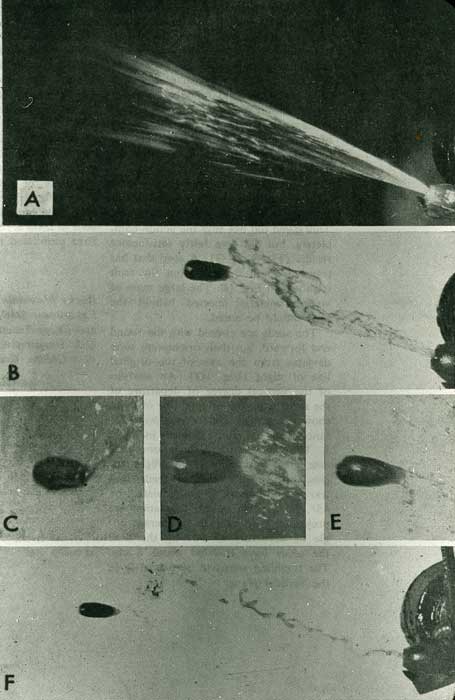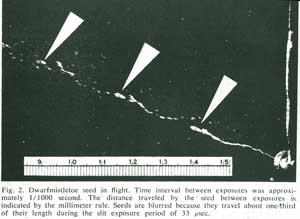Mistletoe dispersal
Exploding fruits
 The adaptations for bird dispersal described above are virtually universal in Loranthaceae, and predominant in Viscaceae. However two genera of Viscaceae are notable exceptions. Both produce seeds which have a sticky layer of viscin on the outside, but both have minute, inconspicuous fruits and seeds, too small to fit the normal pattern of bird feeding and dispersal. In the predominantly American genus Arceuthobium
The adaptations for bird dispersal described above are virtually universal in Loranthaceae, and predominant in Viscaceae. However two genera of Viscaceae are notable exceptions. Both produce seeds which have a sticky layer of viscin on the outside, but both have minute, inconspicuous fruits and seeds, too small to fit the normal pattern of bird feeding and dispersal. In the predominantly American genus Arceuthobium ![]() the fruits are strongly explosive, and are usually oriented at an angle of 45° to the horizontal. When the seed is discharged from the fruit it therefore attains maximum trajectory (see illustration), and the discharge velocity is sufficient to disperse the sticky seeds to adjacent trees in the conifer forests. The other genus, Korthalsella, which is represented in Australia, is reported to have weakly explosive fruits. Korthalsella plants are small (mostly less than 10 cm tall
the fruits are strongly explosive, and are usually oriented at an angle of 45° to the horizontal. When the seed is discharged from the fruit it therefore attains maximum trajectory (see illustration), and the discharge velocity is sufficient to disperse the sticky seeds to adjacent trees in the conifer forests. The other genus, Korthalsella, which is represented in Australia, is reported to have weakly explosive fruits. Korthalsella plants are small (mostly less than 10 cm tall ![]() ), and it seems likely that fruits
), and it seems likely that fruits ![]() discharge when contacted by birds, and that the sticky seeds might adhere to the plumage and feet of birds, and be dispersed when the birds preen. This gives Korthalsella a very different dispersal capacity from other mistletoes (see below under dispersal to remote islands).
discharge when contacted by birds, and that the sticky seeds might adhere to the plumage and feet of birds, and be dispersed when the birds preen. This gives Korthalsella a very different dispersal capacity from other mistletoes (see below under dispersal to remote islands).
![An Australian Government Initiative [logo]](/images/austgovt_brown_90px.gif)


